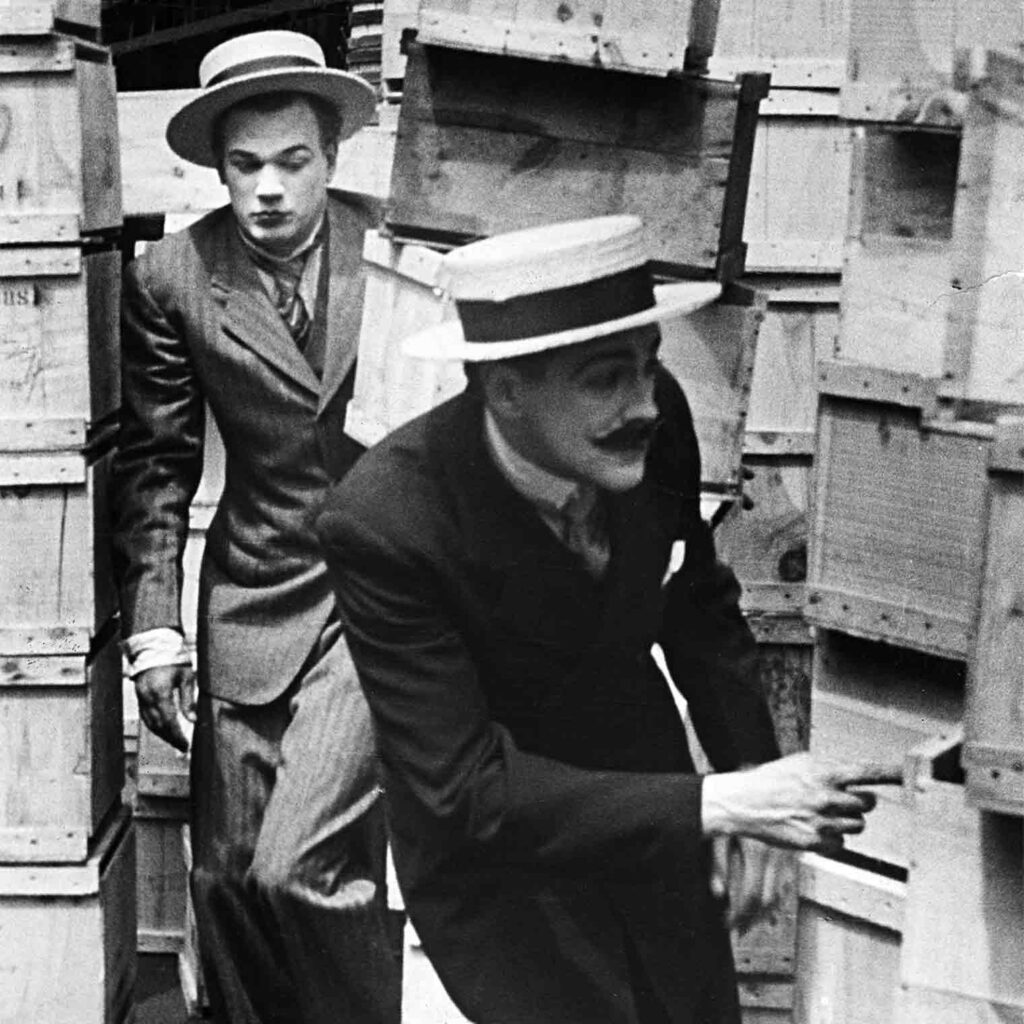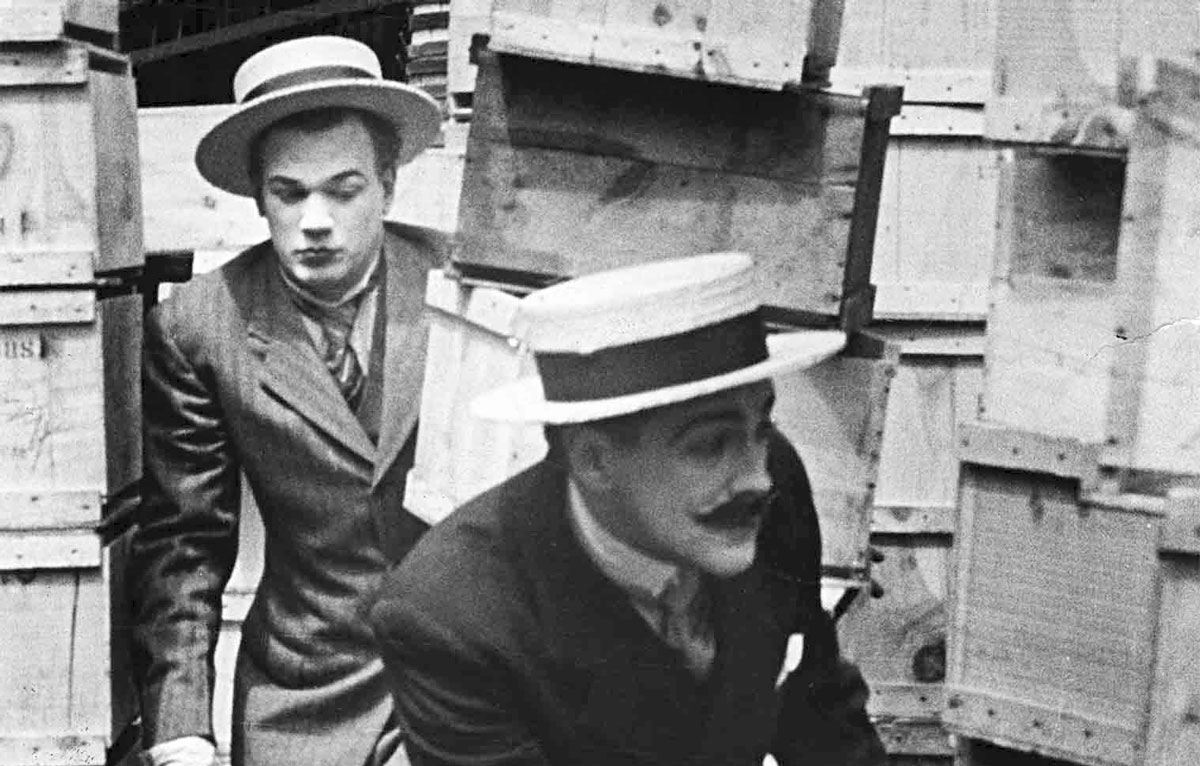Making a silent movie sounds like a fun idea, no? Lots of people with movie cameras — 16mm, 8mm, super 8, and probably also 9.5mm — have done it. Either as a novelty, or as die-hard fans in tribute to the medium they love. As home movie enthusiasts or as film students or professionals, and everything in-between.
Heck, in my days as a teenage super 8 filmmaker I made a few silent movies. One of them was my attempt at what Keaton had done in The Playhouse (1921), using a trick to back-wind the film in a super 8 cartridge and multiple-expose two or three instances of myself. I think the record I hit in Ben Model’s Crazy House (1979) was seven of me waiting in a line to use the bathroom.
My film was shot at 18 fps and shown at 24 fps — my camera had that 18/24 either-or switch on it — and had carefully made intertitles with Letraset rub-off letters on black paper. It was in color. I could’ve shot in B&W, as there was super 8 B&W film and processing at the time. I had filmed another silent short few years previously in super 8 B&W, based on a “silent movie” scenario I’d found in an instruction booklet for a 1930s Cine Kodak 16mm camera.
I loved silent films and wanted to make a movie in that style. And I did the best I could or was up for, given what I knew about the medium.
I used the word “tribute” above, and for good reason.
Anyone who’s made a silent movie has done so out of their love for the medium. At best they are all tributes to Silent Film and, on a handful of occasions, get really close to being a Silent Film. They honor silent movies, are reminiscent of silent movies, they look a lot like silent movies. Both to the people who were the makers of and to the viewers. But if it wasn’t for the fact there is at least one of the basic aesthetics missing, they’d be the real thing.
I would encourage anyone interested in making a new Silent Film who is only now discovering or has recently dipped in to this series of posts to go back to the first one, and read through them all, to acquaint themselves with what the visual storytelling language of Silent Film is, or to at least consider my observations and theories about it is. I would also like to go over a handful of things I’ve seen in many (okay, most) silent films people have made.
While most of the new “silent movies” I’ve seen are close-but-no-cigar as far as what I consider the Language of Silent Film, there are a number of exceptions. These are mostly in the silent films made by friends of mine in the clown and physical comedy community. They’ve been hearing me yammer on about the speed-up and undercranking, and have participated in the experiments I’ve made on my iPhone using Filmic Pro. And maybe there are some new silents out there that really fully utilize the language that I haven’t encountered yet.
But I’d like to take the next few posts to cover some of the things I keep seeing which, clearly, a lot of people think are part of silent movies and just really aren’t.
I’ll start with the era.
Silent Film does not rely on taking place in the 1910s or 1920s. We think of the “look” of silent movies being culturally of those decades. It isn’t necessary as part of the storytelling langue. It’s just that that’s when the silent movies we’re familiar with were made. But it’s not what makes a Silent Film.
I see this a lot — people dressed in century-old-styled costumes and hats. Sometimes there are antique automobiles and other set-pieces and props. It’s not necessary. It may be fun, in a cosplay sort of way, but it’s not a requirement for something to be a Silent Film. It may also be a faint distraction, unwittingly, to your viewer or audience. They know they’re not watching a film from a hundred years ago, after all, and anything that reminds them of this may get in the way of their right-brain experience. Just a little, but it’s a factor.

An audience or viewer is aware of when a film they’re watching was made. No matter how authentic-looking something may be made to appear, we’re still cognizant of the fact that it was made decades after the time it’s supposed to look like. The special effects in Woody Allen’s Zelig (1983) or the classic B&W Hollywood studio look in the recent Mank (2020) are remarkable. But when we watch either of these, somewhere in the corner of our consciousness we are aware these are replications done more recently, and not the real thing. Even with the reel-change cue marks in Mank, we’re aware that these have been added digitally.
This is why the original Twilight Zone resonates – we know we’re watching something made during 1959-1964 and that the shows’ commentaries are of that time. This is why any “reboot” of the show has trouble capturing the magic of the original.
I find I keep referencing Charlie Chaplin in my discussions of all this, and I think bringing him up again here is warranted. Chaplin’s Modern Times was made and released in 1936 (okay, some scenes were filmed in 1935, but you get the point). It is a silent movie, but make no mistake about it — Modern Times takes place in 1936. It may be harder to make the distinction between eras with City Lights (1931), since much of it takes place in that Chaplinesque-Dickensian world some of his films inhabit, but if you look at the costumes and automobiles, that story takes place in 1931. Chaplin’s “post-silent era” silent films take place in the year they were made.
So, please – make your silent movie inhabit the world that is concurrent with its production. Your audience will see it as (vintage) silent movies’ audiences did when they were in their release.
There are some things to cover regarding intertitles, and that’ll be up next.
The first post in this series is here.
The previous post (#61) to this one is here.
The next post “Intertitles for Modern (Contemporary) Times is here.

The more of this blog I read, the more I hope that there’s a book collecting all of the material together (and perhaps expanding on it, even?) out there somewhere in the future. I’m first in the queue, if that happens.
I’m second in line for a book. I was thinking the same thing as I read this!
Yes, I think this may turn out to be a blog-to-book project, after all. I’m glad to know you think these would make a good book subject.
Thanks! I didn’t know how much text I’d have when I started this or how long it would take me to get all the thoughts out, but I’ve added up the word count and do think this may wind up being a “blog-to-book” project. Thanks for letting me know you’d be interested!
Oh, boy this took me back to the early 1970s when I first fell in love with silent films as a young teen. I wanted to make my own silent film and planned to do a split-screen short playing Chaplin (!) and a young woman he was flirting with. I couldn’t find black & white 8 mm movie film anywhere! (Where on earth did you find your b&w film back then?) So I tried shooting a dress rehearsal in color and it looked so bad, I abandoned the project. I did do a practice split-screen film by playing a girl having her fortune told by a fortune teller. The trick worked (rolling back the film cartridge and blocking half the lens during each filming.) but the bright lights needed for filming indoors weren’t bright enough so it came out a bit dark. Plus my acting abilities were sadly lacking to say the least. So, I abandoned my film aspirations rather quickly, LOL. Any chance we can see your early silent film creations?
I don’t remember where I got B&W super 8mm or had it processed, but I remember having to do it all by mail order. Kodak still makes Super 8 Plus-X. I haven’t gotten any of my S8’s scanned but should probably do that at some point.
This company in Burbank can help you with any 8MM needs.
They offer cameras, film and processing and guidance.
https://www.pro8mm.com/